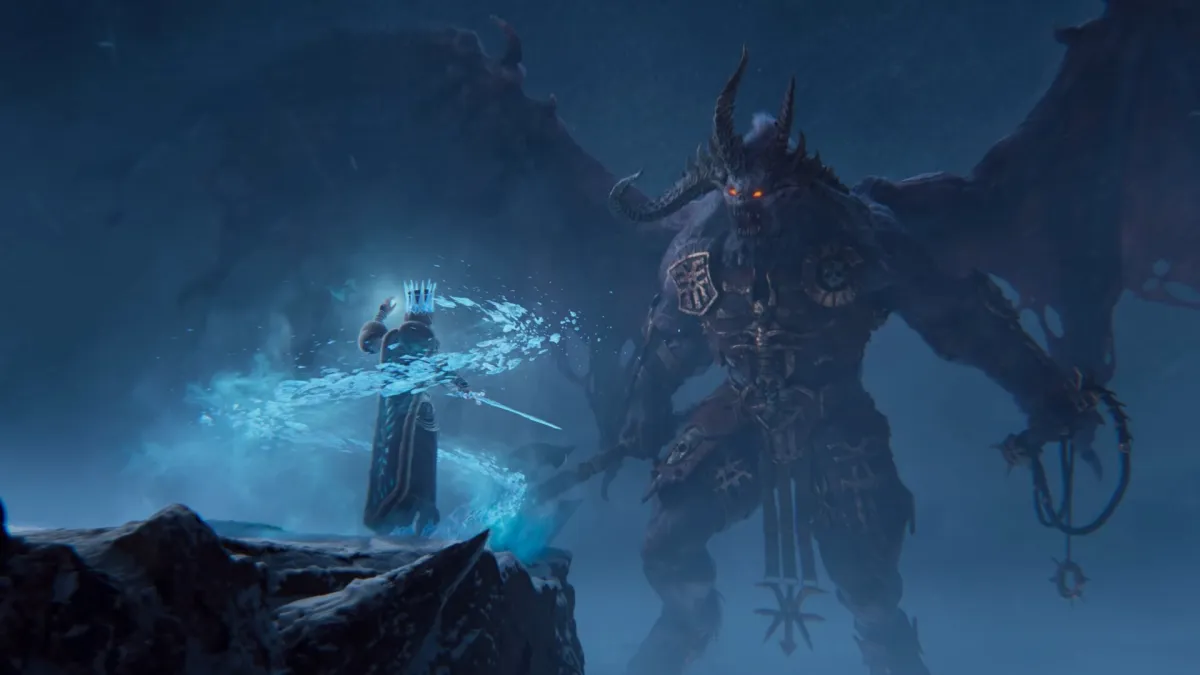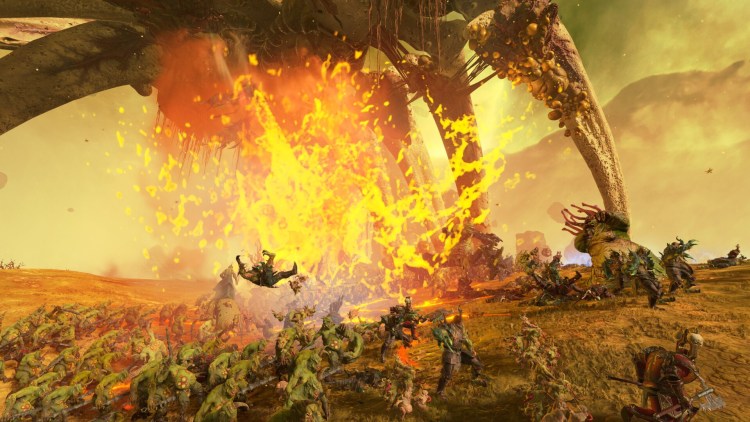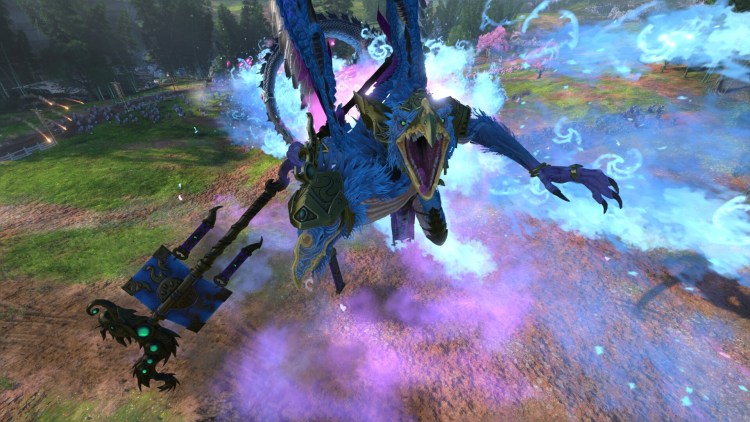Total War: Warhammer III is culmination of a multi-year journey for developer Creative Assembly, and one that many fans have been looking forward to. As the game that caps off the trilogy, it manages to deliver the thrills as you would expect. Still, there were a few missteps that could prove to be detrimental depending on how you approach the campaign.
Our Total War: Warhammer III official review is based on my experiences while playing as the Daemon Prince of the Legion of Chaos, Tzarina Katarin of Kislev, and Miao Ying of Grand Cathay. This is only for single player, as I haven’t been able to test out online battles or co-op (which supports up to eight players now).
Bear with me here
The grand campaign of Total War: Warhammer III focuses on the fate of Ursun, the Bear God of Kislev. An Ungol prince named Yuri is lured into a trap by none other than Be’lakor, the first Daemon Prince of Chaos. After Yuri grievously wounds Ursun, he is transformed by the Chaos Gods into yet another Daemon Prince, all while Be’lakor attempts to use Ursun’s life force to ascend to godhood.
The eight playable factions — and 12 legendary lords that you can start with — have their own motivations knowing that Ursun is in a weakened state. Naturally, the Kislevites want to save their deity. Meanwhile, the four “monogod” factions, as well as the Daemon Prince, aim to appease the dark powers. Then, there’s Grand Cathay, a faction from the far east that wants to bring balance to its glorious empire. And, of course, the Ogre Kingdoms just want to have bear meat for dinner. Each story is told marvelously from the point of view of the Advisor, the same old fella who’s been around since the first game. There are multiple cinematics this time that truly flesh out the lore surrounding the world that Creative Assembly has crafted.
To top it all off, the visuals have never been crisper and more awe-inspiring. You’ll glimpse a variety of battlefields from snow-capped northern lands to the lush valleys of the east. Additionally, you’ll marvel at model details (worth a Charlemagne or two) and dazzling spell effects.
Total War: Warhammer III – The Daemon Prince of Chaos Undivided
I decided to play as the Daemon Prince (formerly Prince Yuri) for my first Total War: Warhammer III campaign. As mentioned in our preview article, the inclusion of a Daemon Prince legendary lord was an absolute surprise. He is, essentially, a blank template — you even give him a name, though the randomizer cooks up suggestions like Arbaal, Kharn, Morkar, and Asavar.
What makes the Daemon Prince unique is that you’re able to dedicate sacrifices to specific gods (i.e., Khorne, Tzeentch, Nurgle, and Slaanesh) or for all of them (i.e., Chaos Undivided). In turn, you’ll receive new weapons, armor pieces, and buffs. Akin to an action role-playing game, the Daemon Prince’s character model changes, too. It’s as though you’re playing Diablo with a character that looks like Diablo.
You also partially acquire a mechanic associated with a specific Chaos God if your reputation is high enough. For instance, you can seduce enemy units thanks to Slaanesh or activate one of Nurgle’s plagues that gives you vanguard deployment. Even better, you gain access to all units from each Chaos God’s roster, mixing and matching to your heart’s content. All these concepts make for a highly customizable and engaging playthrough.
Total War: Warhammer III – Tzarina Katarin of Kislev
After completing the Daemon Prince’s campaign, I went ahead and started a run as Tzarina Katarin of Kislev. In Warhammer Fantasy Battles, the nation of Kislev defended the civilized world from Chaos incursions. However, they’ve never had an official army in the tabletop. Now, in Total War: Warhammer III, you’ve got a full roster of units and three playable lords (one can be unlocked later on).
I genuinely enjoyed Kislev’s playstyle, both in terms of the strategic layer and tactical representation. Many of Kislev’s units are hybrids, a staunch line of Kossars that can shoot foes with arrows or slash them with melee weapons. They’ve got an assortment of cavalry and monsters as well, such as the Elemental Bear (aka Snowy Bear).
In terms of overall strategy, Kislev has deep mechanics that would put to shame most vanilla factions and DLC leaders from the two previous offerings in the franchise. Tzarina Katarin and her rival, Kostaltyn, rely on Devotion to gain supporters (the first one to hit 600 confederates the other, somewhat akin to Hector and Paris in Total War Saga: Troy). Likewise, there are Motherland buffs that provide impactful benefits apart from giving you supporters based on your actions. Next, the Ataman mechanic lets you assign a governor of sorts to a province, allowing you to field them as a general later. Lastly, the Ice Court is where you select traits for Frost Maiden heroes and Ice Witch lords. With your heroes/lords, you can debilitate opponents with Ice magic before striking them down with Tempest spells.
Realms of Chaos and Cataclysm magic
Every faction in Total War: Warhammer III has similar goals to achieve victory in the campaign. First, you’ll need to wait for Chaos Rifts to appear before your general travels to a Realm of Chaos that’s filled with nasty horrors and insidious effects.
For example, the pox-filled lair of Nurgle will cause your army to suffer attrition. In Tzeentch’s case, you need to use teleporters to reach the final area. Meanwhile, the domain of Slaanesh, a Dante’s Inferno-esque “circle of hell,” requires you to hightail it to the center as you’re tempted by nifty rewards. Lastly, Khorne’s requirement is more straightforward, as you just need to defeat a lot of enemies.
The Realms of Chaos in Total War: Warhammer III will certainly amaze those who enter these lands for the first time. The studio has captured the essence of these dangerous regions and their eldritch rulers. Similarly, there’s a sense of urgency, given that other factions are also roaming these areas looking for their prize.
Moreover, the Winds of Magic rework ensures that it’s more fun to go around casting a lot of spells. Another twist is that battles in the Realms of Chaos draw upon an infinite pool of mana reserves (save for Khorne’s domain). Since these are warp-tainted places, you can use new Cataclysm spells — one for each Wind of Magic — to devastate enemy ranks.
Survival Battles
There are, however, notable flaws in Total War: Warhammer III. Firstly, you’ve got Survival Battles. These are lengthy bouts in massive maps to conclude your Realm of Chaos romp. You capture points, gain supplies, construct towers/barricades, and spawn extra reinforcements. While this is going on, wave after wave of deranged creatures will assault your position. The end goal is to reach the third capture zone to defeat a champion.
Mind you, Survival Battles are actually quite brilliant, and I applaud Creative Assembly for its efforts. My only gripe is with the lack of an in-battle save or checkpoint system. These fights last around 30 minutes to an hour (especially at higher difficulties). You can auto-resolve, thankfully, but you could incur losses, too. Alternatively, you could spend a couple of turns replenishing, but the AI might beat you to the punch. So, for those who want to manually try these encounters, you have to be in it for the long haul (and pray that the game doesn’t crash halfway through).
Total tedium halfway through
The second point of contention is a common pitfall of the franchise. By mid-game, it becomes a slog to get through, and this is compounded by the fact that the campaign can be very messy at times. Only your legendary lord can enter a Realm of Chaos to face all the hostiles and nasty mutations therein. Apart from those, the regular rogue armies are joined by doomstacks that spew forth from the warp. If those aren’t enough, you do need to watch out for angry neighbors and corruption/public order issues. It makes for a bothersome Vortex 2.0, unless you limit yourself to guarding a couple of provinces only.
In short, your legendary lord’s squad goes solo for 10 to 15 turns, as your weaker force attempts to defend multiple regions from the Ordertide or Chaostide (sometimes both). Then, you’ll lather, rinse, and repeat these steps for all four realms. You’re looking at roughly 140 turns — most of which are messy and chaotic (pun intended) — before you reach the final battle. And that’s just for the campaign victory, not pure domination. Perhaps the worst part is that the whole endeavor feels slightly unrewarding. Apart from Slaanesh’s temptations, the remaining gods just grant you temporary stuff (Khorne’s weapons even disappear if you go to another realm).
Other tidbits I’ve noticed include the Daemon Prince’s item sets not being fully optimized (i.e., you might not be able to wear two full sets due to item slot requirements), and that Kislev’s Atamans can’t be removed completely (i.e., your only recourse is to deploy them and get them killed). I’ve also seen egregious problems with attacking and pathing for flying units. There were instances when they’d disengage from the melee and you’d have to micromanage their moves again. This was particularly noticeable while playing as the Daemon Prince, since there were moments when he’d swoop in and bash enemies only to fly back up as if all aggro was lost. Moreover, I’ve experienced periodic framerate drops both on the campaign map and in battles.
Total War: Warhammer III is a treat for long-time fans
In the end, however, Total War: Warhammer III still managed to impress me. Although core campaign progression remains similar for all races, the faction mechanics themselves were unique enough to warrant additional playthroughs. As mentioned earlier, I’ve gone through the Daemon Prince’s and Tzarina Katarin’s campaigns, and I’m also halfway done with Miao Ying’s. Key changes and tweaks were also more than welcome, such as the aforementioned magic spells, alongside the ability to construct defenses during sieges, a fast way to balance diplomatic deals, and being able to recruit units from your allies via outposts.
We could see more features in store in the coming months, including other legendary lords (Thanquol being my fave), Regiments of Renown, and an “Immortal Empires” mode that lets you pick every leader you’ve obtained from past titles. Indeed, Total War: Warhammer III is the culmination of a saga and something I’ve come to enjoy. If you’re up for it, you can take a look at our technical review as well. We’ll also have a guides and features hub soon.















Published: Feb 14, 2022 2:00 PM UTC